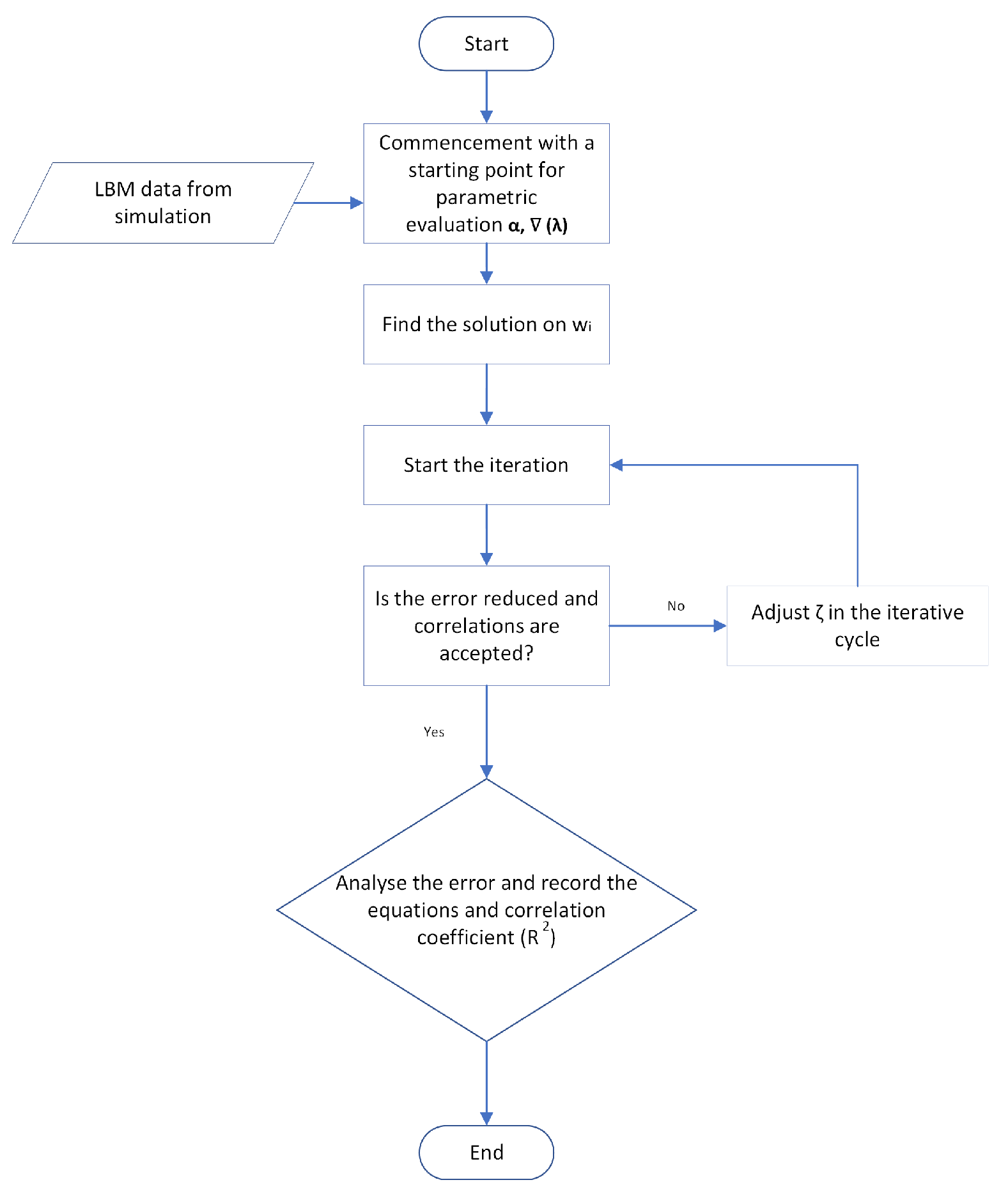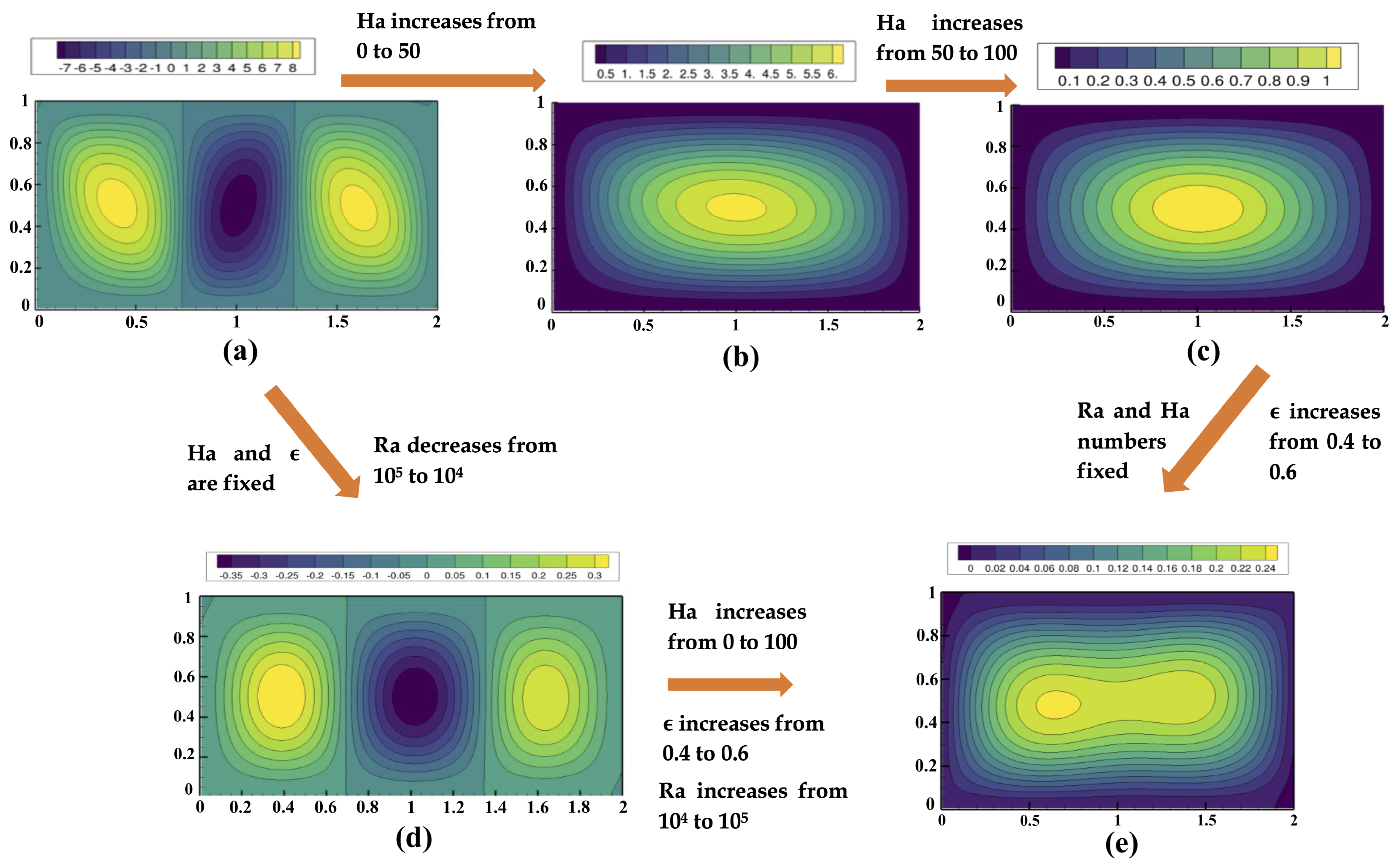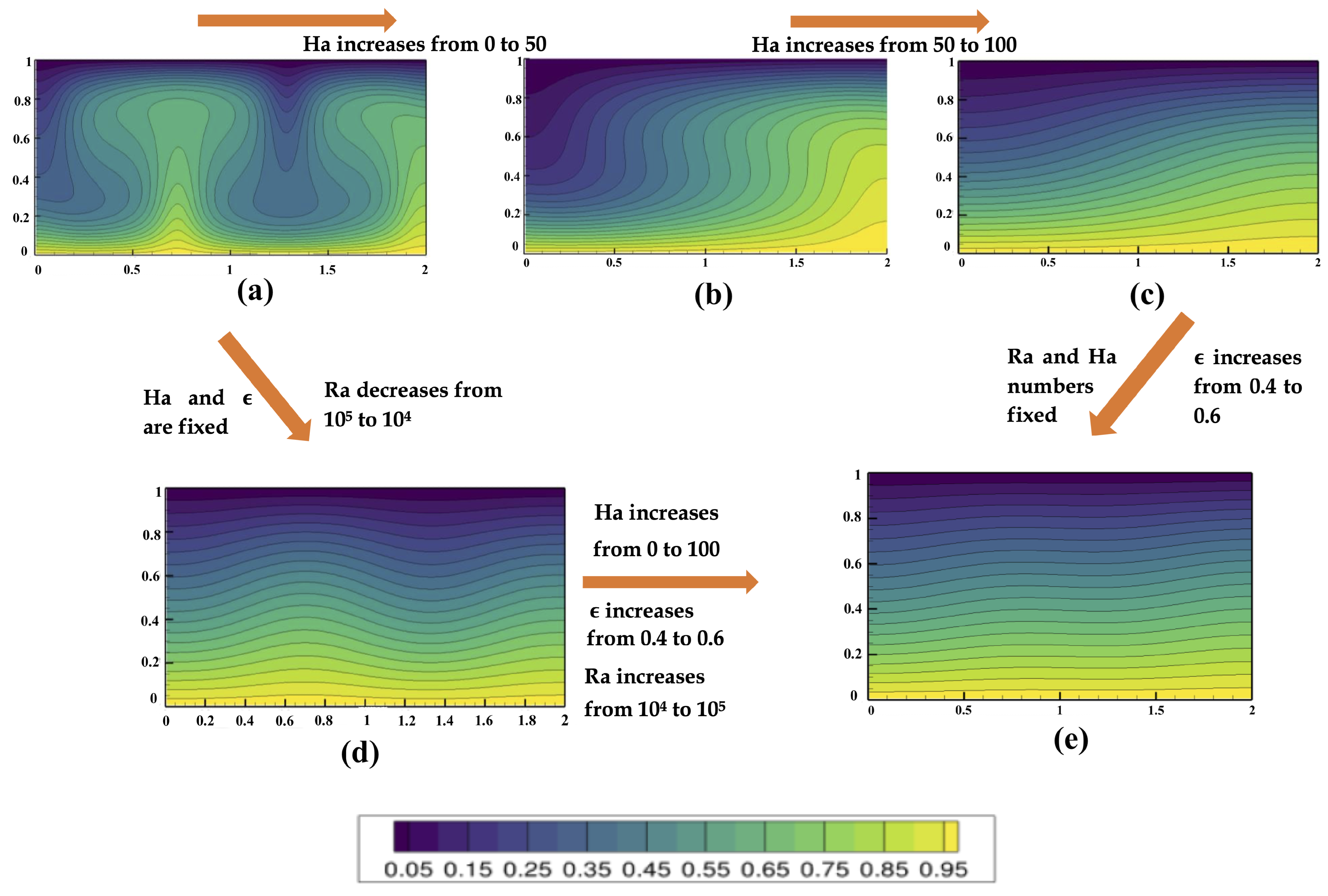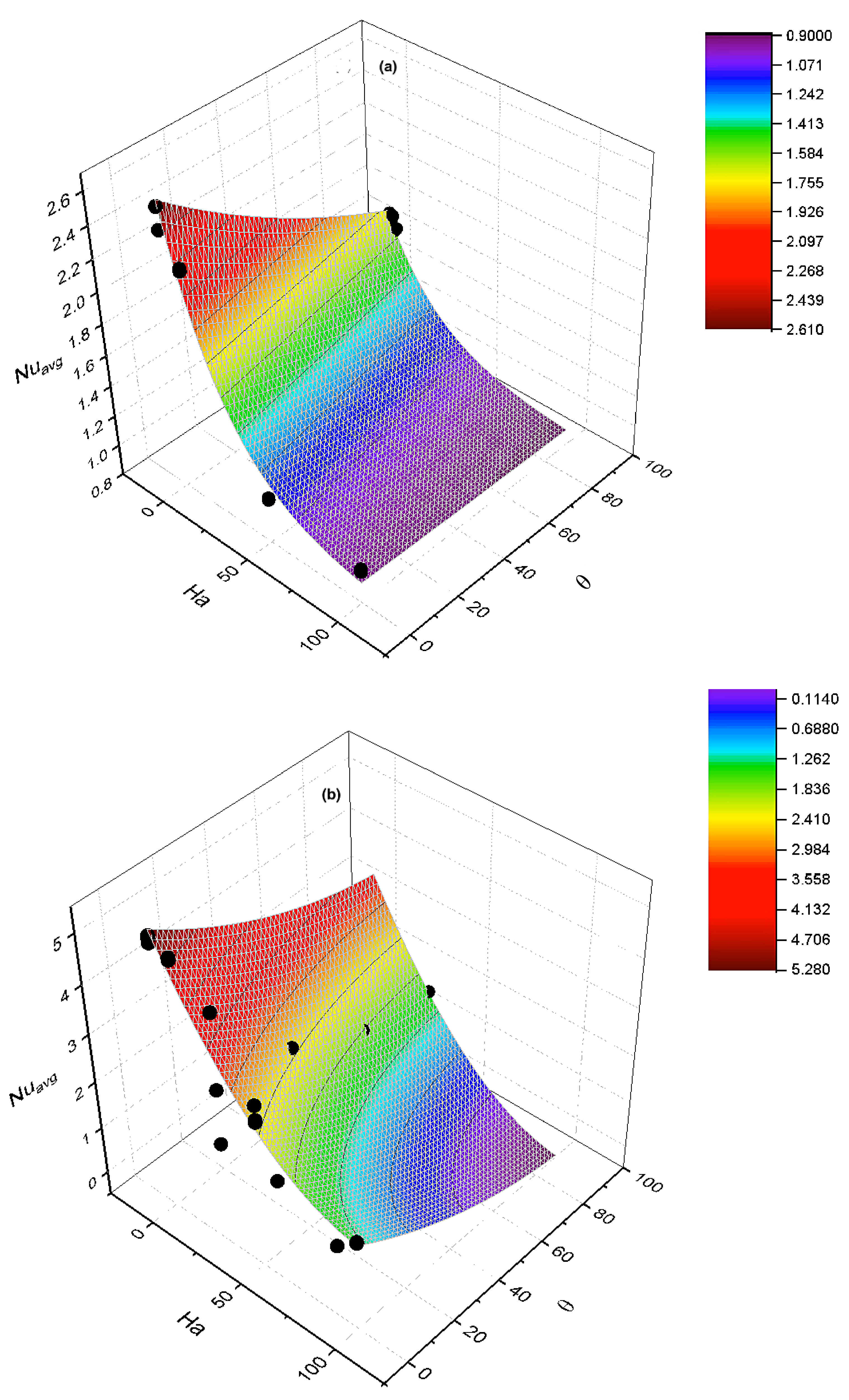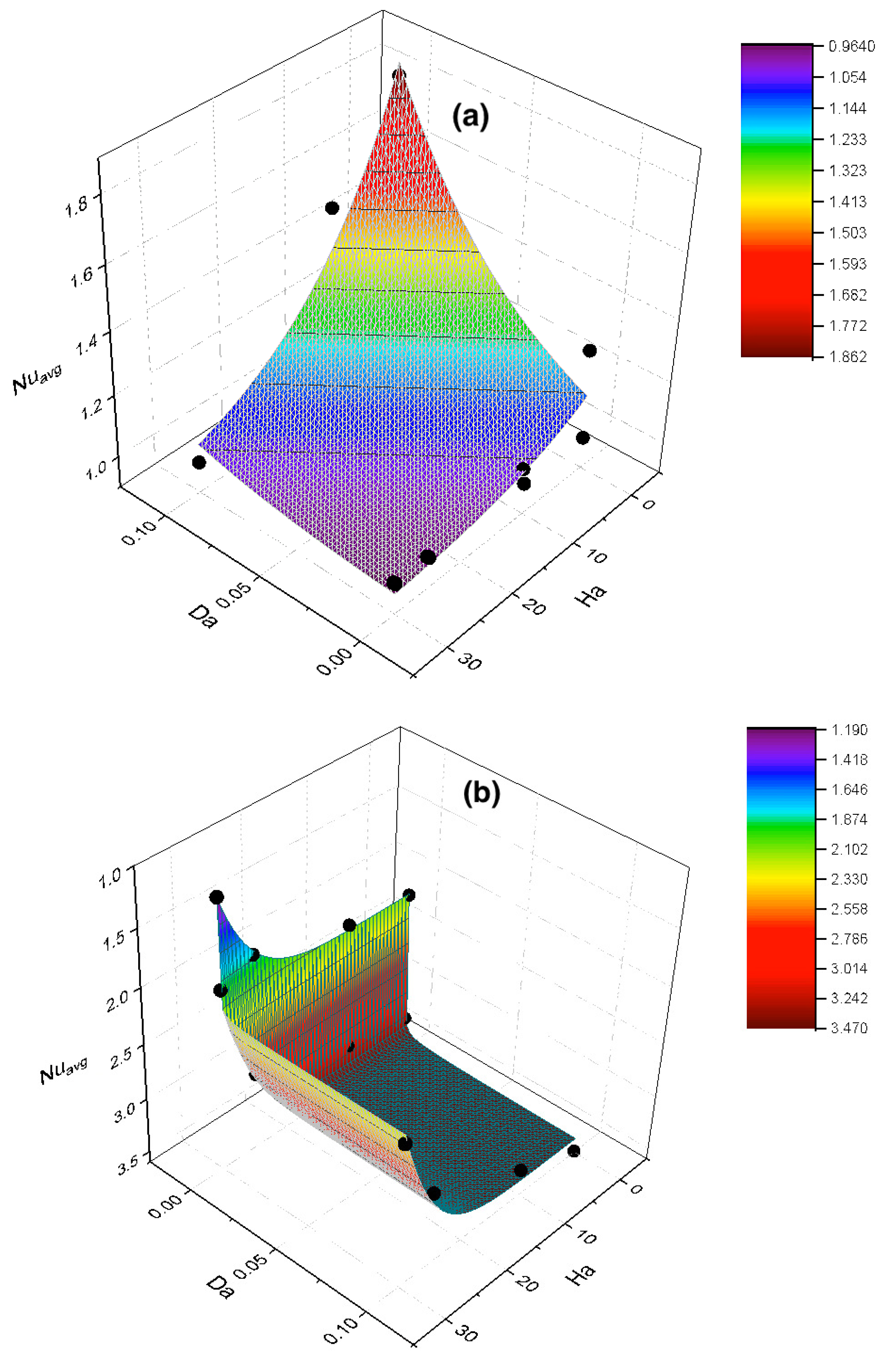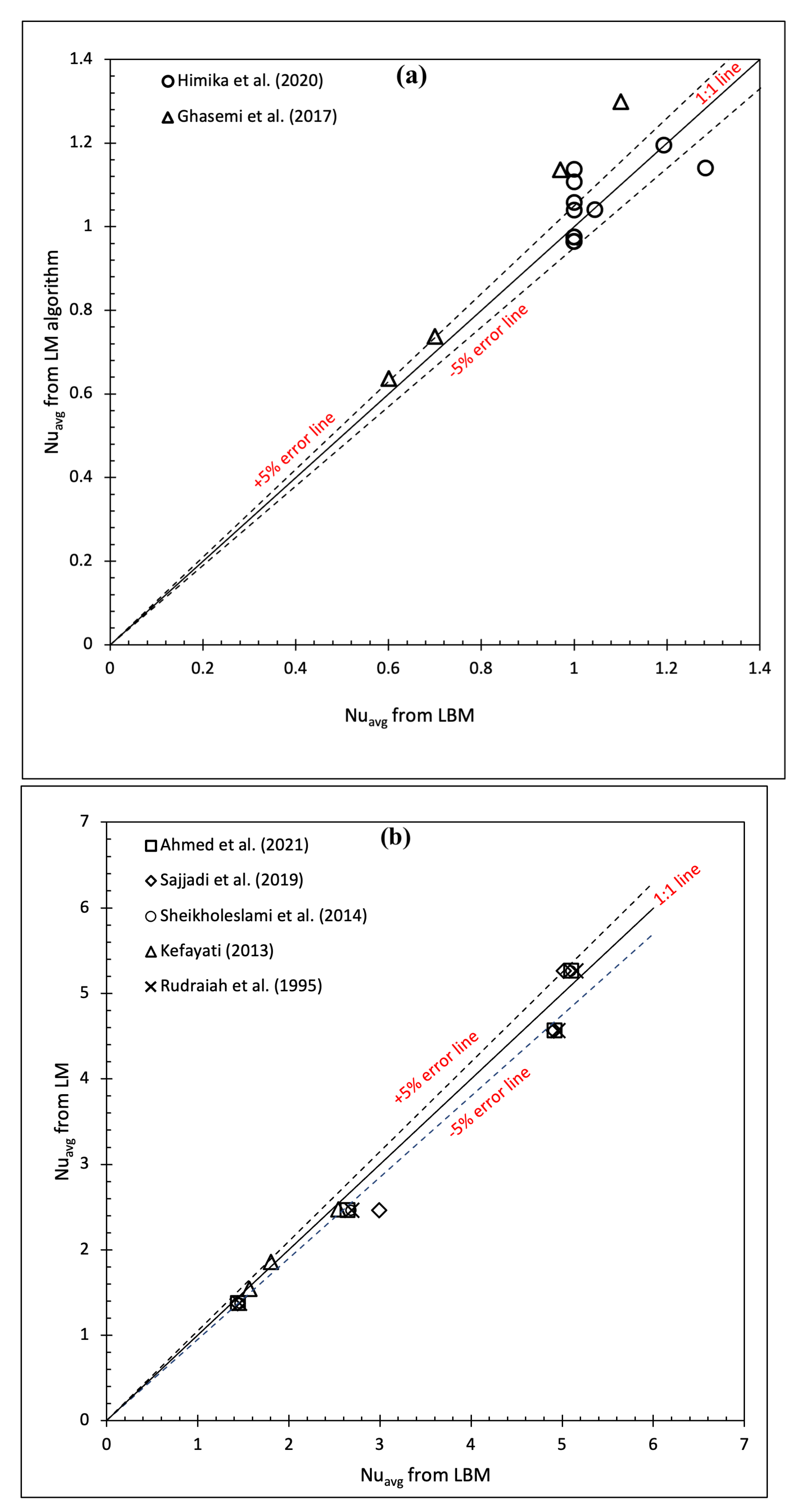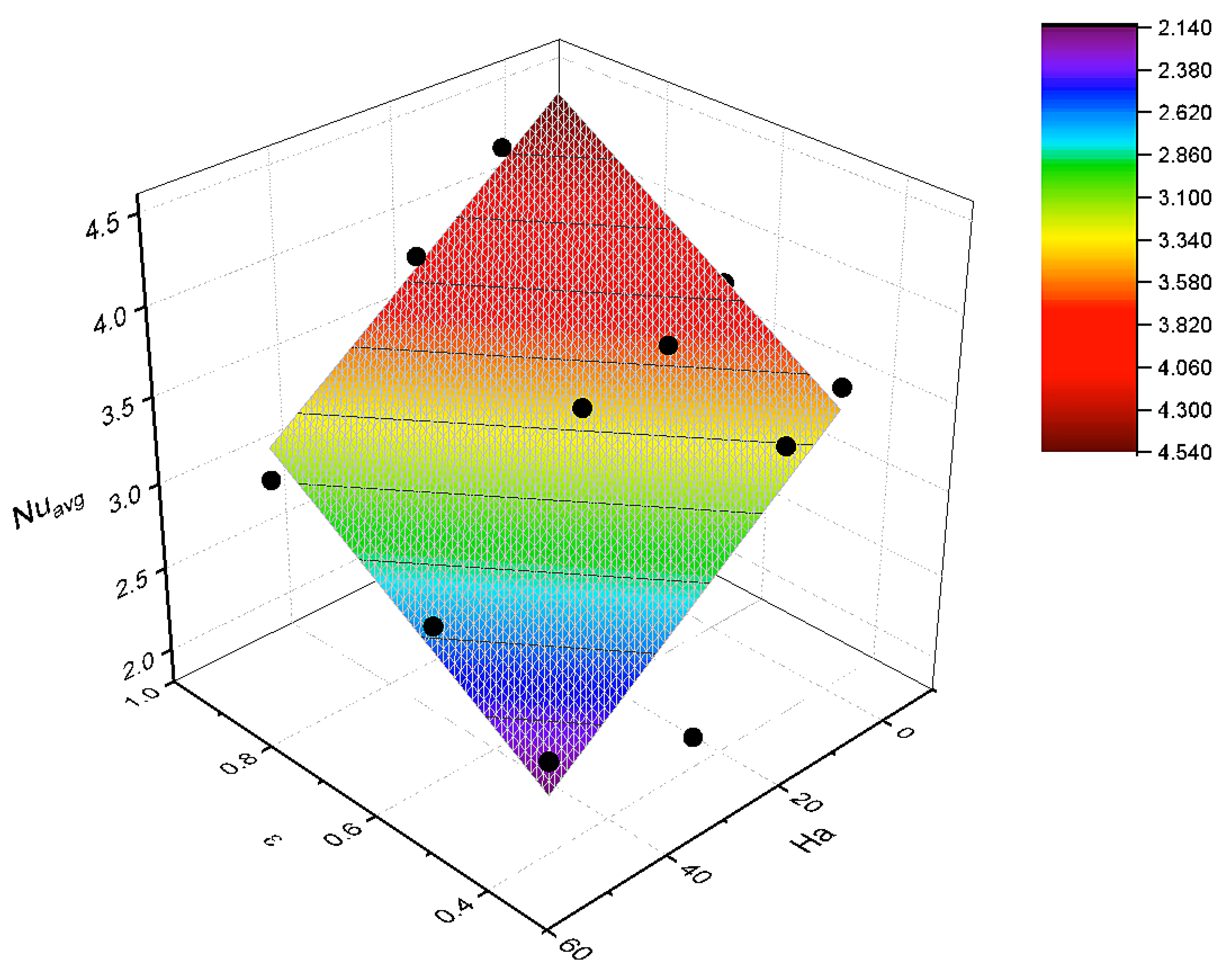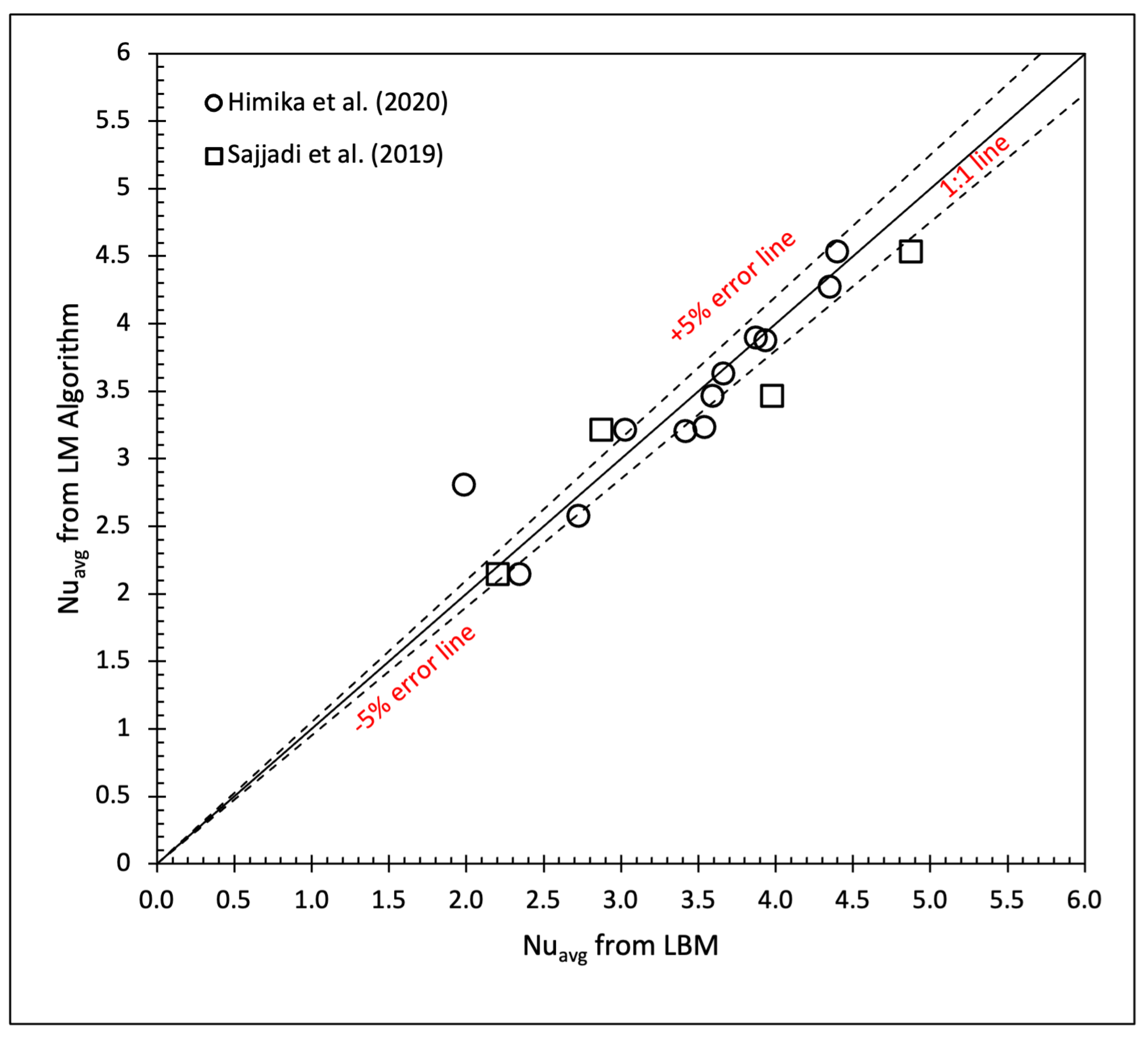1. Introduction
The lattice Boltzmann method (LBM) is an efficient approach to investigate fluid flow through numerical simulations across different geometries at microscopic, mesoscopic, and macroscopic scales [
1,
2,
3,
4,
5,
6,
7,
8]. LBM is based on statistical mechanics and has immense potential to establish a data-driven analysis for scientific progress [
9,
10,
11]. Therefore, high-dimensional nonlinear LBM data could be taken into account to calibrate any statistical model through high-performance computing (HPC). With the increasing demand for HPC, researchers have shifted their focus to fluid flow simulations by considering LBM across complicated grids [
5,
12,
13,
14,
15]. LBM has been found to be efficient in flow simulations and heat transfer applications in hydrology, magnetohydrodynamics, and aerodynamics, to name a few [
16,
17,
18,
19,
20]. Magnetohydrodynamics (MHDs) represents electrically conducting fluids in liquid metals and plasma flows. The applications of MHD have been reported in a wide range of applications, such as thermal engineering, geophysics, nuclear and hydroelectric power plants, astrophysics, and so on [
18,
21,
22,
23,
24]. Therefore, the analysis of heat transfer in convective flow could be established by utilizing the LBM-MHD scheme.
The study of numerical heat transfer through different media is one of the popular fields of study among researchers [
25,
26,
27,
28]. Rayleigh–Bénard (RB) convection is one form of a phenomenon that takes place in a fluid layer assigned to a vertical temperature gradient and heated from the base [
18,
29,
30,
31]. The difference between buoyancy and gravity leads to fluid instabilities and convective electrical currents. This type of instability has been the subject of extensive research to identify a procedure to stabilize the system. One major reason could be the lack of understanding of the LBM data and correlations of the output with the input variables prior to the numerical modeling [
32]. Therefore, it is necessary to determine the correlations to predict any upcoming phenomena linked to fluid instability. Several authors reported successful outcomes in stabilizing a system by applying an external magnetic field due to the induced electrical currents within the fluid [
18,
33,
34]. However, most of the works were based on analysis through certain numerical parametric variations. Therefore, the prospect of establishing an LBM data-driven approach to determine correlations with the heat transfer prediction remains unnoticed.
Machine learning (ML) and deep learning (DL) are two important sectors of artificial intelligence (AI) with the ability for accurate data analysis and prediction model development [
35,
36,
37,
38,
39]. With computational resources, ML and DL can build a multivariate model by taking high-dimensional non-linear data and developing correlations and numerical prediction models within different sectors. The model needs to be trained with a dataset to calibrate the model, and validations are performed through internal and independent datasets. However, the prediction model needs to be optimized through efficient training methods [
40]. An inadequately optimized model will perform below the standard and yield noise within the model, leading to low correlation to predict the outcome. The Levenberg–Marquardt (LM) algorithm is one of the training methods for ML models, particularly for artificial neural networks (ANNs). LM develops the correlations by considering the input variables to provide a nonlinear least squares minimization (NLSM) solution. Therefore, it indicates that any numerically simulated data, including those from LBM, could be fed into the LM algorithm to understand the correlations among the variables through a quasi-ML approach along with numerical validations with the literature.
There is a shortage of literature on LBM data analysis through any efficient algorithm. However, some recent studies have reported the utilization of neural networks to optimize LBM data under the influence of MHD in natural convection. For example, Alqaed et al. [
41] studied natural convection and entropy generation by applying a magnetic field with ANN and presented an equation based on the correlation development. However, the ML modeling equation lacks information on whether it can be used to predict total entropy across all geometries. In addition, the equation was not validated against any published literature to showcase the accuracy and robustness. Shah et al. [
42] followed similar steps by adding radiation heat transfer. However, the validation methodology and the equations to predict the entropy remained ambiguous. On the other hand, the study presented by He et al. [
43] was a much-improved one, as the correlation developments of LBM data were efficiently described through ANN and internal validations. Yet, the independent validations were still missed, and therefore, the accuracy of the correlations could not be expanded beyond the internal database.
This study aims to address the shortcomings within the literature by analyzing LBM data to establish correlations by considering the numerical variables, such as Rayleigh () number, Darcy () number, Hartmann () number, inclination angle (), and porosity (), to predict the average rate of heat transfer () by the LM algorithm. The obtained equations are presented in each section, including the statistical accuracy indicators, followed by validations within the literature in each step under various circumstances. The correlation coefficients () are found to be between and , which provides more confidence in the accuracy of the numerical model.
2. Geometry of the Porous Cavity
The schematic diagram of the porous cavity along with associated coordinates is illustrated in
Figure 1. The rectangular cavity in the 2D configuration includes the effect of a magnetic field to investigate the RB convection by considering incompressible and laminar fluid flow. The LBM data were extracted within these specifications. The cavity was assumed to be filled with electrically conducting fluid.
H denotes the vertical height, and the horizontal length is denoted by
L, where
. Two vertical side walls were considered adiabatic, i.e., no heat transfer will occur. The top and bottom walls are cold and heated, represented by
and
, respectively, where
. The LBM data were extracted through different parametric variations, such as the Rayleigh (
) number within the higher buoyancy range (
and
). Three different Darcy (
) numbers were considered, namely,
, and Hartmann (
) numbers were considered to be between 0 and 100 to investigate the impact of the magnetic field. The impact of the magnetic field was further studied along with different inclination angles (
) ranging from 0 to 90. The porosity (
) was between 0.4 and 0.9. The gravitational acceleration (
) was acting downward. The uniform magnetic field was considered to be
B in
Figure 1. The study assumes the Joule heating and viscous dissipation to be negligible to focus entirely on the impact of the magnetic field [
18]. However, through the Boussinesq approximation, this particular assumption is validated, which ignores the density gradient, except from the appearance where the former is multiplied by
.
4. Materials and Methods
LBM simulations for MHD-RB convection were performed in Fortran 90 [
56] by using Microsoft Visual Studio Code
TM. Boundary conditions, collision operators, streaming functionality, and convergence criteria were all included as subroutines. The base code considered all those subroutines for the iterations. The iterations continued until the convergence criteria were obtained. The computations were performed on a Windows 10 computer in an 11th Gen Intel(R) Core
TM i9 2.60 GHz processor with 64 GB RAM. The streamlines and isotherms were visualized by using Tecplot 360 2022 R1 version (
https://www.tecplot.com).
As mentioned earlier, the LM algorithm was performed through the R programming language [
57] by RStudio
TM open source software using library packages
pracma [
55], followed by data organising, equations validation, and correlation development in OriginPro [
58]. The library package
pracma determines a large number of functions from the numerical analysis for any math function. Prior to that, the popular
dplyr [
54] package was used for data manipulation and visualization. It should be mentioned here that the same computer was utilized for LM algorithm development, which was also used for the LBM simulations. However, both RStudio and OriginPro were operated with NVIDIA RTX A3000 GPU power for fast implementation of the model optimization and correlations development.
5. Results
The primary purpose of the present study is to develop the correlation among the important variables to quantitatively predict number, which is representative of the average heat transfer rate. Therefore, the results will discuss the numerical correlations based on LBM-MHD data interpretation through the LM algorithm. Each segment demonstrates the obtained outcome from the non-linear surface analysis, followed by validations with literature to showcase the accuracy of the obtained equations. However, two separate comprehensive analyses are first conducted to pinpoint some of the significant changes in the streamlines and isotherms.
5.1. Effect of Numerical Parameters on Streamlines
The impact of
and
numbers, as well as
on streamlines, is illustrated in
Figure 3 under a constant
. The combined analysis will depict each variable’s influence on the streamlines’ pattern.
Figure 3a is assigned with
,
,
, and
, leaving entirely no impact of the external magnetic field. As per
Figure 3a, three separate circular rolls distributed within a symmetry within the cavity were observed. However, the circular rolls in the left and right locations of the cavity exhibited almost similar characteristics with the maximum contour values at the center. However, the circular roll in the middle demonstrated the opposite and negative contour values. This behavior could be attributed to side-heated adiabatic walls and the top and bottom walls being active in the heat transfer process. Therefore, the circular roll in the middle directly depicted the effect of convective characteristics instead of conductive ones [
18]. However, as the
number increased from 0 to 50, the shape and contour values changed significantly, as seen in
Figure 3b. The Bénard cell reduced from 3 to 1 and started to stretch from the central region. The maximum contour value also reduced from 8 to 6, which is almost a 25% reduction due to the 50% augmentation in the
number. Therefore, it was expected that increasing
number would keep on reducing the heat conduction. The hypothesis was confirmed from
Figure 3c, where the maximum contour value at the center plummeted to 1. By increasing the
number from 50 to 100, the maximum contour value reduced by approximately 83.33%, indicating the negative influence of the external magnetic field and the existence of restriction within the cavity to reduce the heat transfer mobility.
In the second part of this analysis, the influence of
numbers and
was observed. By comparing
Figure 3a and
Figure 3d, the impact of the
numbers could be observed by keeping
and
constant. As
decreased from
to
, the maximum contour value decreased from 8 to 0.3, which is a rapid 96.25% reduction. With this observation, the impact of buoyancy in the RB convection could be understood. In the next part, all the variables, namely
and
numbers, and
were increased concurrently as shown in
Figure 3e. According to
Figure 3e, three Bénard cells reduced to one but demonstrated strong attraction toward the thermal walls by showing similarity with the thermal dipole. The maximum contour value was 20% reduced from 0.3 to 0.24, and no negative value was recorded. While the increased Ha number was directly responsible for negative contour values, the increased
and
numbers enhanced the heat transfer phenomena, leading to 0 as the lowest contour value within the cavity. The impact of
was also tested by keeping
and
numbers constant. By comparing
Figure 3c,e, the influence of
could be analyzed, where the maximum contour value decreased from 1 to 0.24. However, in both
Figure 3c,e, the
number is 100, which repelled the heat transfer application. Therefore, the contour value reduced significantly by about 140%.
5.2. Isothermal Changes
The final section of the results focuses on the changes in the isotherms, similar to the previous section.
Figure 4 represents such changes in five different frames.
The impact of
can be observed from
Figure 4a–c by increasing from 0 to 100 in three separate frames. The distribution of isotherms is kept within 0 to 1. As per
Figure 4a, the isothermal lines demonstrate an oscillating pattern due to the heat transfer within the cavity without the influence of
number. The pattern within 1 to 1.5 of the horizontal axis is the opposite of what was observed within 0 to 1 of the same axis. This behavior could be linked with the conduction and convective rolls observed in
Figure 3a, where the middle convective rolls represent the negative contour values. Therefore, the pattern of the isotherm from 1 to 1.5 on the horizontal axis is the opposite. As the
number increases from 0 to 50, the isothermal lines exhibit uniformity within the cavity, as the oscillation disappears and all the lines start to become quasi-linear as seen in
Figure 4b. The presence of the
number leads to the presence of a magnetic field which develops the Lorentz force within the cavity. Therefore, the instability within the thermal walls is reduced. Further decreasing oscillation could be observed from
Figure 4c, where the isothermal lines edge closer to the linearity. While a wavy pattern could be seen at the lowest contour, the isothermal lines are quite linear at the maximum contour values, which are closer to the horizontal axis.
Meanwhile, the effect of plummeting
numbers could be observed from
Figure 4d, where decreasing
from
to
significantly impacts the isothermal patterns. It could be observed that due to the decreased buoyancy, the isothermal lines show minor oscillation with a minimal peak in each line. The isothermal line close to the horizontal axis show a linear pattern due to the lack of buoyancy strength within the cavity. However, as
is increased from 0 to 100,
is increased from
to
, and finally,
is also increased from 0.4 to 0.6. The isothermal lines are almost linear throughout the cavity due to the strong influence of the
number in particular as seen in
Figure 4e. In fact, keeping
constant and increasing
from 0.4 to 0.6 does not significantly impact the isothermal lines either, due to the existence of the Lorentz force. By comparing
Figure 4c,e, the impact of the
number in the RB convection could be well understood.
5.3. Predicting from Number and
In this part of this study, individual equations to predict under the influence of an external magnetic field in an inclined rectangular cavity are developed for and . The key element of this analysis is the consideration of the electrically conducting fluid in RB convection. Different simulations were conducted at number based on the LBM model at . The LM analysis was performed to build the correlation, followed by the validation with well-cited literature from the past and the recent. In general, good accuracy was established. The correlation is only valid for , which are the most preferred ones for laminar flows as per the data from the literature.
5.3.1. Development of Correlation and Surface Analysis
Non-linear parabolic and power correlations were found to be the best-fitting ones among different functions for
and
, respectively, under the LM algorithm. The correlation coefficients (
) were found to be
and
for
and
, respectively.
Figure 5 depicts the 3D contours for better visualization. It could be observed that the high density of the points was more aligned with low
, as most of the important transition in the heat transfer takes place under low
and
. This behavior could be attributed to the effect of the magnetic field, which is directly controlled by the
number. At an increasing
number, the rate of heat transfer declines due to the existence of both an electric field and magnetic field, leading to the presence of a Lorentz force. Consequently, increasing the
number lowers the values of
. However, as part of the validation, a wide range of
numbers and
was considered to demonstrate the accuracy of the model and its ability to predict the heat transfer value outside the calibration zone.
As presented in
Figure 5,
between
and
was obtained from the surface analysis. The equation, however, is expected to be valid to predict
beyond the obtained range in the analysis due to the consideration of a broader range of
and
. In order to obtain the equation from the best-fitting simulated contour from the LM algorithm, the LBM-simulated data were subject to several surface analyses for the purpose of interpolation within the user-defined range, and the following equation provided the best
:
where
f,
a,
b, and
c are fitting parameters with assigned values specifically under the aforementioned condition.
Table 1 contains the values of the fitting parameters obtained through the LM algorithm with the best
value.
As
increases from
to
, the impact of buoyancy inside the enclosure augments significantly. Therefore, Equation (
36) is not an appropriate option to predict
as a function of
numbers and
. In fact, different functions were considered to determine the best-fitting surface to obtain the equation to predict
at
. The following equation provided the best coefficient of determination to predict
:
Table 2.
Fitting parameters to predict from number and inclination angle at .
Table 2.
Fitting parameters to predict from number and inclination angle at .
| Empirical Parameters | Fitting Values |
| f | 5.26782 |
| a | −0.07321 |
| b | −0.03499 |
| c | 3.43333 |
| d | 0.000162 |
| Statistical Accuracy Indicators | Values |
| 0.897 |
| p | < |
It should be mentioned here that the p-value outlines the significance of the statistical study implemented in this section. The lowest p-value indicates that the null hypothesis was rejected, and the correlation is statistically significant. Overall, was considered to be a good indicator to validate the model’s accuracy.
5.3.2. Cross-Validation with Literature
The cross-validation was conducted with the literature with a similar objective. However, none of the literature provided any clear mathematical correlation among the parameters. The data from the literature were not considered to calibrate the LM model. Hence, the cross-validation serves as an independent validation to show unbiased agreement with the LBM and LM data within the considered range of input parameters.
The validation plots presented in
Figure 6 demonstrate good agreement between
predicted from LBM and LM simulations. The majority of the points were obtained to be within the
error lines. To build the model, the validation dataset contained a similar geometry considered in this study. The separate validation plots represent the agreement for two different
numbers (
) considered in developing Equations (
36) and (
37). The empirical parameters presented in
Table 1 and
Table 2 were considered to obtain the
as presented in
Figure 6a,b, respectively. A separate
Table 3 is presented to indicate the accuracy individually with the literature data considered for the validation. As mentioned in the caption of
Table 3, some outliers were ignored in the individual
calculation since it was already considered for the overall
determination. It should be mentioned that filtering the outlier point is a common practice in statistical analysis, and hence the influential negative point can be ignored.
Table 3.
Obtained in each validation with literature individually. Detected outliers were removed for the correlation development.
Table 3.
Obtained in each validation with literature individually. Detected outliers were removed for the correlation development.
| Ra | Rudraiah et al. [59] | Kefayati [60] | Sheikholeslami et al. [61] | Sajjadi et al. [62] | Ahmed et al. [16] |
|---|
| - | - | | | |
| | | | | |
Figure 6.
Cross validations with LBM data from the literature (
a)
[
16,
61,
62], and (
b)
[
18,
62,
63,
64] under the influence of external magnetic field at different inclination angles for electrically conducting fluid.
Figure 6.
Cross validations with LBM data from the literature (
a)
[
16,
61,
62], and (
b)
[
18,
62,
63,
64] under the influence of external magnetic field at different inclination angles for electrically conducting fluid.
5.4. Correlations among , Numbers, and Numbers under Constant Porosity
The major focus of this section is to predict as a function of the number () and the number (), at constant variables, such as porosity () and inclination angle (). The data were obtained through LBM RB simulation, and a correlation was developed through the LM algorithm. Two different numbers were considered in this section of the study.
5.4.1. 3D Fitting Curves and Statistical Parameters
Repeated LM algorithm simulations were performed to obtain the best-fitting results. As per
Figure 7, the fitting curves are presented for
(
Figure 7a) and
(
Figure 7b), where the distribution of the LBM-obtained data is shown. At higher
numbers, it was anticipated to have the lower
; therefore,
was considered for the model calibration. However, the independent validation was conducted with the published literature, where the
number was expanded up to 50, and still, significant agreement was established. On the other hand, a wide range of
numbers was considered in this part of the simulation. Therefore, the model could still develop a correlation at a higher
number.
The obtained equation to predict
is the following (for
):
The equation to predict
at
yielded the best
under the power function, which was found as the following:
where
f,
a,
b,
c,
d, and
e are empirical parameters to adjust the fitting surface and build the correlation.
Table 4 and
Table 5 show the quantitative values of those parameters and statistical information of the LM model, which were the foundations of obtaining Equations (
38) and (
39).
According to
Table 4 and
Table 5, the numerical values obtained from the LM algorithm are presented. The correlations were obtained to be
and
, for
and
, respectively.
5.4.2. Independent Validation
The independent validation was conducted with the literature to showcase the ability of the correlation with data. The purpose of such an approach is to validate the present approach with well-cited data from the past and the recent, collectively.
Figure 8 presents the validation results obtained through the present approach for
(
Figure 8a) and
(
Figure 8b), respectively. It was found that the majority of the points were near the 1:1 line, and the agreement was within the
error lines. The agreement plot also demonstrated the range of the
being as high as 4, which is mostly observed at a lower or no
number. Therefore, the present approach was able to predict LBM results within multifarious ranges with a low percentage of error. The
of each comparison in the validation is presented in
Table 6, where
was obtained, which provides more confidence in the accuracy of the present approach. Due to the limited data in the literature, the number of points presented in
Figure 8a is less than those of
Figure 8b.
5.5. Equation to Predict under Variable Porosity
In this segment of statistical analysis, porosity () is considered as a variable under the fixed , and numbers. The primary focus is to establish a correlation under variable porosity (), which is quite sensitive to other variables concurrently. Therefore, and are considered for the sensitivity analysis.
5.5.1. 3D Fitting over a Planar Surface
It was anticipated that under constant and numbers, and , the increasing rate of will be linear as a function of and , considering the fact that remains constant in each step while varies. For example, it was pinpointed earlier that the increasing number significantly plummets the heat transfer rate. However, if remains unchanged, yet increases, the will increase linearly due to the improved convection inside the cavity since the number is also unchanged.
Figure 9 serves as a testimony of the aforementioned statement, where a planar correlation was obtained through the LM algorithm. The
depicts the accuracy of the correlation, which can be improved further with more relevant data within the plane. The distribution of the points within the surface implies that a suitable range was taken into account to predict
over the multifarious
and
Ha .
The equation to predict
under this circumstance was obtained to be the following:
The values of the empirical parameters from Equation (
40) are presented in
Table 7. The simplified version of the equation was also found to be effective at elevated
numbers; however, due to the insufficient data in the literature, the validation was not conducted beyond
.
5.5.2. Validation Result
The immediate validation was conducted to assess the accuracy of Equation (
40). The independent validation data were obtained from the literature reported by Himika et al. [
18] and Sajjadi et al. [
62]. The
error lines were also included in a similar manner for better visualization of the agreement.
Figure 10 illustrates the agreement between the literature (LBM data) and the present LM method. In general, most of the points were found within the error lines. The statistical accuracy indicators presented in
Table 7 suggest that the agreement was still acceptable. The range of
was found to be close to 5 (LBM-obtained result), which was, in fact, obtained at
and the highest porosity considered in this research pipeline, i.e.,
.
Table 8 shows the
values found from the agreement presented in
Figure 10. The values of
were found between 0.85 and 0.93 in comparison with the literature data mentioned earlier. All the relevant points were considered for validation. The specific point located beyond the
error line was still considered, and hence the
was found to be 0.85 when comparing with Himika et al. [
18]. However, if those specific data were left out, the
increased significantly to
.
6. Discussion
6.1. Significance of the Study
The LBM is a powerful and efficient alternative to solving fluid dynamics problems. LBM simulations can provide an accurate outcome within a shorter time scale compared to other relevant techniques, such as finite difference, finite element, and finite volume. All of the methods are accurate and have pros/cons. However, the explanation of the correlation among the input variables to quantitatively predict heat transfer was hardly reported. The present study utilizes input variables, such as number, number, , number, and to predict MHD-RB convection within a porous enclosure. The input parameters in the relevant study were mostly chosen to showcase the impact of buoyancy or porosity for the purpose of visualization. Nevertheless, there was always a gap in having equations numerically predict , which can be further validated with well-cited literature.
LBM data are highly non-linear. The current study considered the LM algorithm as one of the ML training methods to build non-linear surface analyses to develop three-dimensional correlation among the variables to predict . In each segment of the correlation development, validations were conducted, and statistical parameters were mentioned as part of the accuracy indicators. Furthermore, the empirical parametric values are provided in a tabular form after the statistical analyses, which will allow the researchers to reproduce the work based on the requirements. The reproducibility of the work by the LM algorithm could be established in different ways. One of them could be to perform direct LBM simulations by varying the input parameters to build the dataset, followed by correlation development to predict . In that case, the process could be time-consuming. The dataset could be split into for the model development, and the rest for the validation. However, validations with relevant well-cited literature need to be performed to understand the efficacy of the approach. It is recommended to consider a sample size of 100 for this approach. Alternatively, the interpolation of a limited dataset could be another option. However, this part also requires the initial model development and creating a dataset through simulations. However, the approach should consider the highest and lowest possible range of each parameter within the geometry to interpolate. The LM algorithm combined with the R library package “dplyr” assists the data manipulation without any involving any complicated steps. It is possible to establish a dataset with 3000 points through interpolation without the need to run LBM simulations varying each parameter. The present study considered both aforementioned approaches.
The current study aims to fulfill such requirements by interpolating datasets for the purpose of validations. The validations by comparing with identical geometries and physical properties with relevant literature provide another form of evidence on a high level of accuracy of the present approach. Some of the similar approaches in fluid dynamics study are worth mentioning. Recently, Islam et al. [
6] presented correlations to predict
by considering input variables, such as Darcy (
) numbers, Rayleigh (
) numbers, and porosities to predict
by the LM algorithm. At the same time, the equation and associated empirical parameters were utilized to validate the GPU-optimized LBM model. However, the work of Islam et al. [
6] was fairly restricted to heat-transfer phenomena of the nanofluid without the influence of an external magnetic field or representative non-dimensional parameter, such as the
number. Meanwhile, the present approach did not consider any machine learning or deep learning approach for the data-driven approach, but the inclusion of artificial intelligence in fluid dynamics study has become widely popular recently and should represent the state-of-the-art approach. It can be stated that no approach can be considered a direct validation yardstick, as numerical methods are not
correct, but the concept of correlation development as an additional form of validation has been reported. For example, the ANN modeling of nanofluid under magnetic field influence by Shah et al. [
42], Alqaed et al. [
41], and He et al. [
43] attest to the purpose of the data-driven approach being included in LBM simulations of fluid flow. Nevertheless, this is the first work which has provided validations in each segment to showcase the potential of the data-driven approach in fluid dynamics by correlations development through the LM algorithm without the need for implementing machine learning methods or high computational resources.
Experimental fluid dynamics is time-consuming, delicate, and expensive [
65,
66]. If the boundary conditions, simulated data, and final representative contours are not fully understood numerically, the experimental approaches could cost a fortune. In an industrial setup, it will always be beneficial if numerical modeling contains correlations that are repeatable and reproducible. Based on the equations, the researchers will be able to test and tune the parameters within the domain to obtain the best-performing model to meet the scientific requirements. Then the final model development can be established through the original fluid flow simulations with the best-fitting input parameters to save time and increase productivity as well as profitability. The equations presented in this study had coefficients of determination (
) between
and
, which are within the standard acceptable range.
6.2. Factors Affecting the Accuracy of the Equations
The present study is based on LBM data. To build a proper correlation, a wide range of datasets is required. While the present study established the correlations with a large number of the dataset, those did not cover the whole domain of the input parameters due to a lack of data for the validation. For example, the
number could be as large as 200 or even more, which could reduce the
. The LM algorithm will not be a viable option for this approach. A machine learning or deep learning approach should be an appropriate method for such an option.
Figure 5 correlations represented
, and while model calibration was feasible, there were no relevant data found in the literature for comparison. Furthermore, the present study considered laminar flow only. The
number could be more than
, and it can cover a wide range of turbulence through the increased buoyancy. Nevertheless, a lack of efficient data in the literature within the considered geometry restricted the present study to explore further options. Since machine learning or deep learning was not considered in this study, further extension of the input parameters was not explored. Some of the references had only 3–4 relevant points (for example,
Figure 6a), and therefore, the limited data could have affected the accuracy of the respective equation. While the surface analyses were conducted based on interpolation of the dataset with at least 3000 data, more validation data would have improved the
values of independent validations. For instance,
Figure 8b contained 31 points for the independent validation, and
was obtained by comparing with three of the references [
18,
62,
63].
In addition, the LM algorithm is susceptible to noise and may downgrade the efficiency of the neural network. However, those impacts are most visible for complex geometries. Since the present study considers a 2D porous cavity, the error percentage was acceptable. The re-tuning of the parameter would have been more efficient by considering any step associated with supervised machine learning model development. However, machine learning models require more data to train and test and cannot provide any equation for the direct implementation in the study. The data considered in this study were sufficient for the LM algorithm and correlations development. The good agreement with the independent validations attest to such a statement.
6.3. Future Recommendations
The key findings of this study offer a major hint that a machine learning model can be developed to train LBM data into a well-suited model. Therefore, building correlations to predict an output parameter by considering multiple input parameters to build multifarious LBM models is highly recommended and is under strong consideration by the authors. Furthermore, the present study aimed to provide equations under different input parameters to predict . In most of the fluid dynamics research, entropy generation is also determined to demonstrate the fluid irreversibility. Both heat transfer and fluid friction are responsible for fluid irreversibility, particularly for nanofluid study. The correlation development to predict total entropy will also lead to another highly correlated parameter, the Bejan number (), which is the ratio of the heat transfer irreversibility to total irreversibility due to heat transfer and fluid friction. Therefore, determining the total entropy generation is one of the major indices in heat transfer application and should require involving more input parameters. Considering the multifarious input parameters involved in affecting entropy generation, machine learning is a suitable method and will be further explored.
Finally, the present study was validated with the simulated results from CPU-based computing. Considering the multivariate model development discussed above, CPU-based computing will be tedious in terms of the machine learning approach. In addition, a 3D implementation will be required to replace the 2D model, which could also consider more complicated lattice models, such as
and
, replacing the
of the present study. The possible implications of GPU-based LBM simulations will significantly reduce the computational time and increase the efficiency of the model. Considering a parallel computing platform, such as the Compute Unified Device Architecture (CUDA), could be a better method for implementing the MHD-LBM hybrid machine learning model. Some of the relevant works minus the machine learning have been published by the authors [
14,
67]. Therefore, developing a machine learning model through GPU computing for LBM cross-validations, possibly in a 3D geometry, will be a milestone within LBM research.

